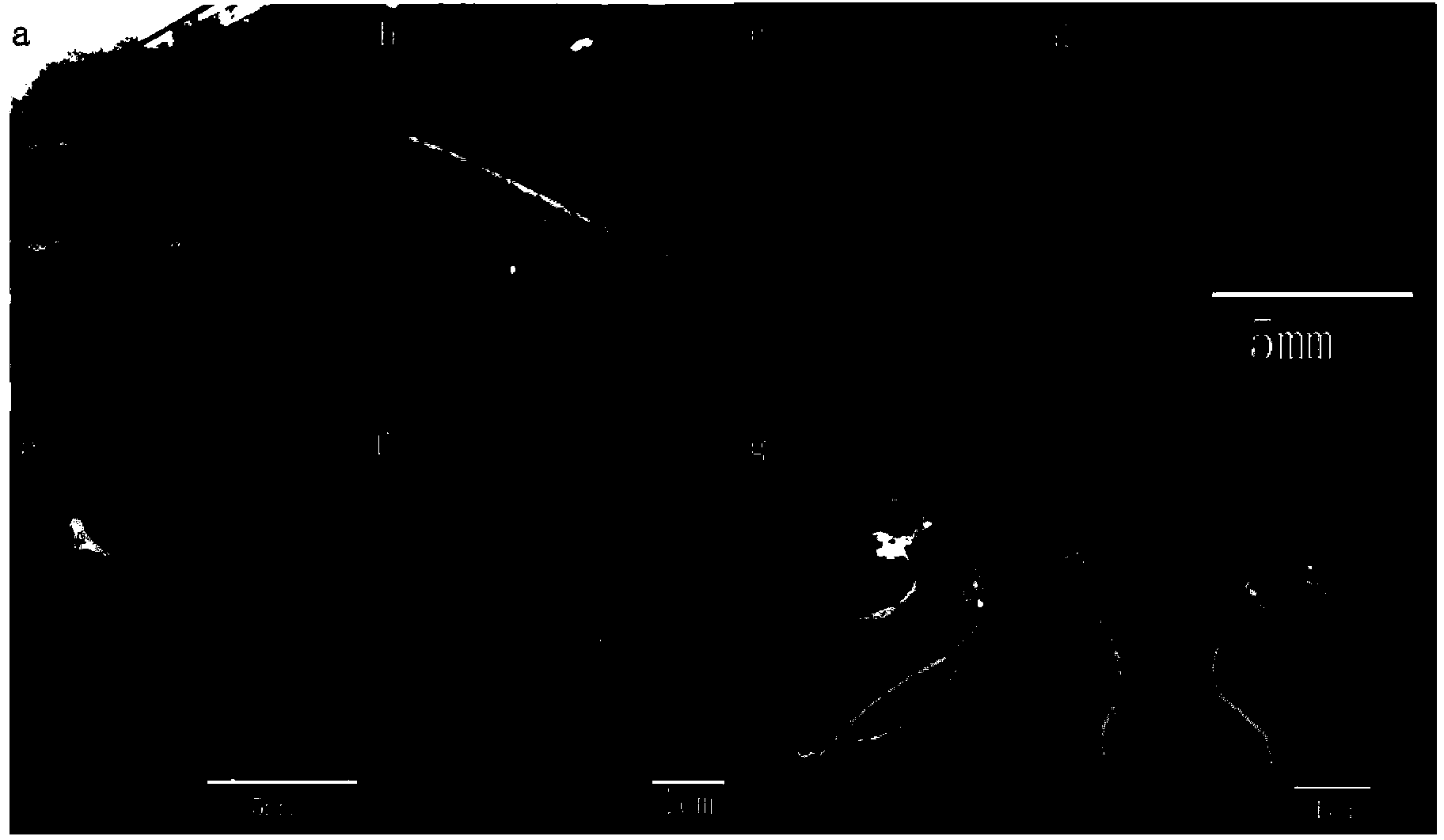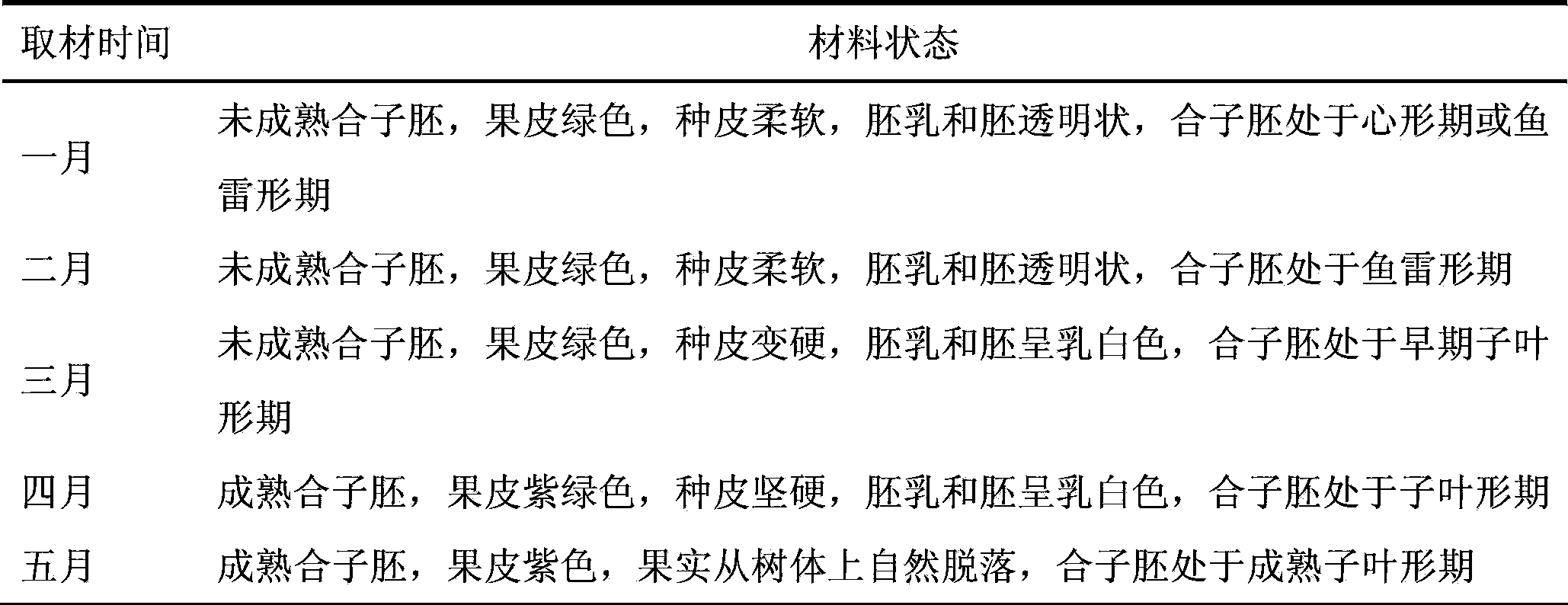Method for Regenerating Plants from Somatic Embryos of Osmanthus fragrans
A technology for somatic embryos and plant regeneration, applied in the field of plant tissue and cell culture, can solve the problems of difficult organs and the inability of callus to differentiate further, and achieve the effect of high coefficient and short reproductive cycle.
- Summary
- Abstract
- Description
- Claims
- Application Information
AI Technical Summary
Problems solved by technology
Method used
Image
Examples
Embodiment 1
[0034] Embodiment 1: the screening of osmanthus zygotic embryo sampling site
[0035] The zygotic embryo of the osmanthus tree of the test material was taken from the fruit of the osmanthus tree Jingui (the variety is a kind of osmanthus tree commonly cultivated in Wuhan, Hubei Province, China) that grows robustly and is more fruitful on the campus of Huazhong Agricultural University (see figure 2 a,b in). The sampling time was in the morning of fine weather in March. After the fruit was harvested indoors, add a small amount of washing powder and wash it with tap water for 1~2 hours, remove the outer testa and pulp for disinfection, and put it in an ultra-clean workbench with 75% (V / V) sterilized alcohol for 30 seconds, rinsed twice with sterile water, then disinfected with 0.1% (W / V) mercuric chloride for 10 minutes, and rinsed three times with sterile water.
[0036] Will complete osmanthus zygotic embryo (see figure 2 c) were cut into cotyledons respectively (see figur...
Embodiment 2
[0040] Embodiment 2: the screening of sweet-scented osmanthus zygotic embryo best development state
[0041] The zygote embryos for the test were taken from the fruit of the vigorous and fruitful osmanthus tree "Jingui: "Jingui: fruit (this variety is the osmanthus tree variety commonly cultivated in Wuhan, Hubei Province, China). In the morning of the weather, the materials are collected every 30 days or so (in case of rainy weather, it can be adjusted appropriately), until the fruit is fully mature and falls off naturally in May.
[0042] Remove the outer testa of sweet-scented osmanthus seed, pulp and carry out disinfection, and disinfection method is with embodiment 1. Use zygotic embryos of different development states as explants (Table 1), cut 1-3mm fragments on the ultra-clean workbench and inoculate them in MS in time, add 0.5mg / L 2,4-dichlorophenoxyacetic acid ( 2,4-D), 1.0mg / L 6-benzylaminoadenine (6-BA), 30g / L sucrose and 7g / L agar, in a callus induction medium wi...
Embodiment 3
[0047] Embodiment 3: Osmanthus fragrans embryogenic callus induction medium screening
[0048] The zygote embryos of the test material were taken from the Jingui fruit of the strong and strong Osmanthus fragrans tree in the campus of Huazhong Agricultural University. The materials were collected in the morning of fine weather in March, and the outer testa and pulp were removed after the fruit was collected indoors and then disinfected. The specific disinfection method was the same as in Example 1 above. The embryos of the sterilized seeds were completely peeled off, cut into small fragments of 1-3mm on the ultra-clean workbench, inoculated in MS respectively, and added 0~2.5mg / L 2,4-dichlorophenoxyacetic acid ( 2,4-D), 0~2.5mg / L 6-benzylaminoadenine (6-BA), sucrose 30g / L and agar 7g / L, medium pH 5.8~6.5 for induction (Table 2), cultured in the dark at 25°C for 30 days (the same conditions as in Example 1), to obtain embryogenic callus.
[0049] Table 2 Effects of different h...
PUM
 Login to View More
Login to View More Abstract
Description
Claims
Application Information
 Login to View More
Login to View More - R&D
- Intellectual Property
- Life Sciences
- Materials
- Tech Scout
- Unparalleled Data Quality
- Higher Quality Content
- 60% Fewer Hallucinations
Browse by: Latest US Patents, China's latest patents, Technical Efficacy Thesaurus, Application Domain, Technology Topic, Popular Technical Reports.
© 2025 PatSnap. All rights reserved.Legal|Privacy policy|Modern Slavery Act Transparency Statement|Sitemap|About US| Contact US: help@patsnap.com



